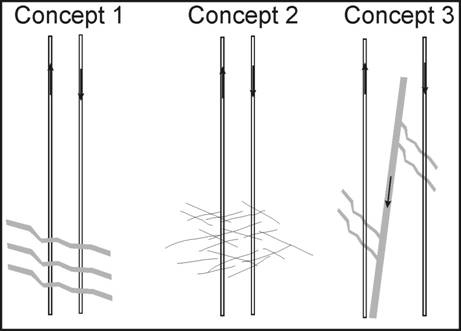

Innovative Network
for Europe




Prepared by
Saulius Šliaupa, Gediminas Motuza, Vykintas Motuza, Vytautas Puronas, Larisa Korabliova, Kirstina Čiuraitė
 |
Geothermal Potential of Hot Granites of Lithuania (*.PDF) |
 |
HDR/EGS Potential of the Vilkyciai area, West Lithuania (*.PDF) |
 |
Geothermal Models of Hot Granites of West Lithuania |
Hot-Dry-Rock (HDR) for long time has been a synonym for heat, extracted from deep hot crystalline rock (> 5000 m). This idea was presented during the first oil crisis 25 years ago. The aim of this concept was to use the inexhaustible and at any place available energy for electricity production.
Hot Dry Rock concept is based on the assumption that deep crystalline basement rocks are dry and impermeable. Therefore, it was necessary to induce artificial fractures acting as heat exchange surfaces. The fluid circulation is performed in a closed loop where the fluid pressure is maintained as such a level to prevent boiling. Steam for electric energy production is produced in the secondary loop at low pressure or by using secondary fluid with low boiling temperature.
Electric energy production can be achieved economically at temperatures above 150oC. Today a combined use of heat and electricity is considered as being more attractive. HDR systems have to produce a thermal capacity of 10 to 100 megawatts over a period of >20 years to get into the range of economy. Such size of a system requires heat exchange surfaces of 3 to 10 km2 and circulation rates of 50 to 100 l/s. For a HDR reservoir of a depth of 5 kilometers the minimum pumping pressure required is about 40 MPa. The flow impedance (the difference between inlet and outlet pressure divided by the flow rate at the outlet) should be in the range of 0.1 MPa s/l. The circulation on a pressure level higher than the hydrostatic rock pressure associates with fluid losses by fluid penetration into the rock matrix.
Three basic concepts of HDR were progressively considered (Fig.1):

Fig.1. Basic HDR concepts
The aim of a HDR system is to create large heat exchanger fracture systems. Presently, the only method by which such fractures can be generated is the method of hydraulic fracturing. Fracturing is achieved by injection of fluid into the borehole by high capacity pumps. When the fluid pressure reaches a critical value an axial tension fracture will originate at the borehole wall and will propagate into the rock with an orientation perpendicular with respect to the minor principal stress direction. Results show that the induced fractures reach a length of several hundred meters and a vertical orientation. In comparison to sedimentary rocks the crystalline rocks of HDR systems are characterized by extensive natural joints and fractures which certainly may play a dominant role in the fluid circulation system.